Conversations with Underwater Photographers: Aaron Wong by Henley Spiers
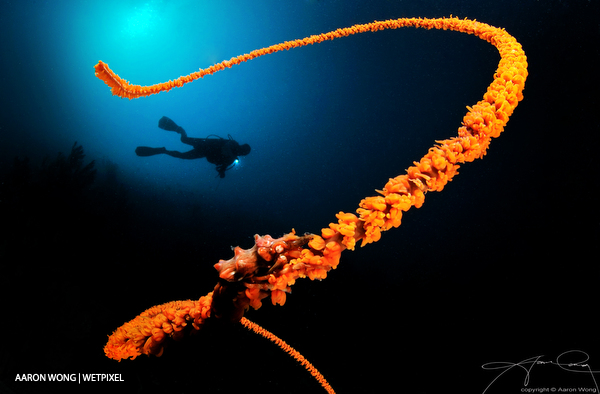
Aaron Wong - Interview by Henley Spiers
In the latest in the series, I talk with Aaron Wong, a commercial photographer from Singapore and highly renowned underwater photographer. What fascinated me most about Aaron’s story is his unfamiliar path into the underwater genre. Unlike most of us, who start out as keen divers and then progress into underwater imagery, Aaron had a strong background within professional studio photography before he even went diving or picked up an underwater housing. As such, he brings a meticulous approach to the use of light in his images, which has inspired me to get more creative and deliberate with my strobes. The portfolio showcased here comprises underwater photos falling under the natural history and fashion genres, my personal interest lies firmly within the former, but I was pleasantly surprised to find that even the pool shots elicit a strong response to me.

Henley Spiers: How did you start in photography?
I was a commercial photographer way before I was an underwater photographer. In Singapore we have to serve in the Army, whether we like it or not, so it was a two-year mandatory service to the government, and once I came out of the armed forces, I had wanted to be a photographer from day one, I knew it all along. But unfortunately for me, I’m 42 years old now, but back in the day, we didn’t have a lot of photography schools like we have now so the only way you could do it was to be an assistant to somebody. And I remember looking to classify for that. This was before the internet and all this stuff, in the mid-90s, so the internet was in its infancy so you couldn’t use that to search. So I was looking for a class, and I found a studio that I could work with as an assistant and then that’s how it all started. So I started my photography career in the studio as an assistant to one of the more prominent photographers in Singapore.
And you had shown an inclination towards that as a child growing up?
Yes, I mean, I’ve always known that I wanted to be a photographer. My dad is into photography. So I had kind of a crash course introduction, and I’m looking through the lens you know, playing with my dad’s cameras and all that stuff. So I’ve always liked the idea of capturing moments. I remember being fascinated by how film works, and this was really the film days. And so I self-taught a bunch of darkroom processes and I processed my own slides. I mean those were the days when we rented dark rooms and go there and do our own projects and things like that. I liked the entire process of how we capture things on film, and of course, with film you need to have a lot of knowledge. I mean now it’s easy, right? You take a picture, and it’s too dark, you just do another one. But those were the days when you had to have light-meters to know what you’re doing. You have thirty-six shots if you’re lucky and if you’re working on a Hasselblad, you have eleven shots. And so that’s how it all started: from the love of film.
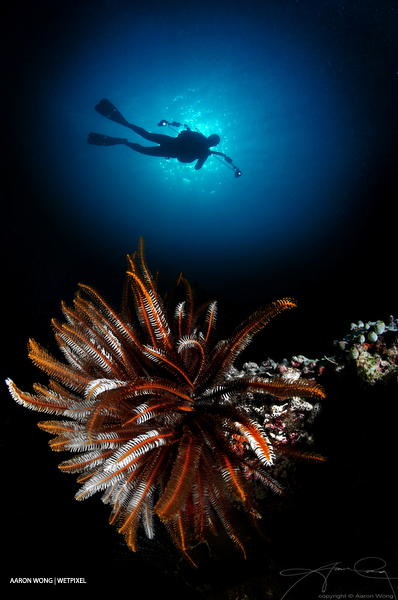
And was there a particular type of photography that appealed to you when you started out?
I think it’s very common for a lot of photographers to start off with street photography. I guess it’s the least expensive thing to get into. You get a camera with some film in it, and then off you go. You don’t have to hire anybody, you just shoot whatever you see. And so I remember the first time, shooting the first roll of film and I went to some street in Chinatown to shoot a bunch of old folks doing Tai Chi in the morning - that kind of stuff.
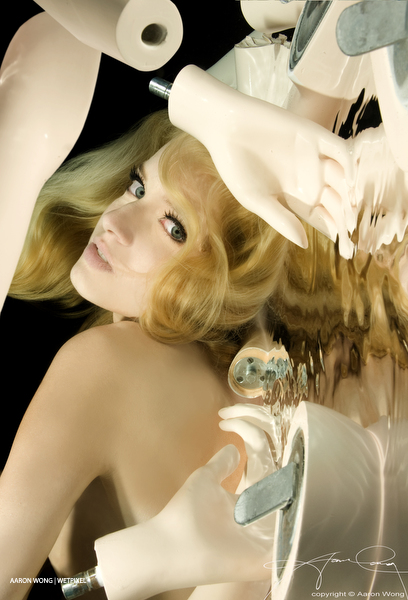
I’m curious because actually, you’re really a photographer whereas most underwater photographers start out as divers and then get interested in that. So when does the diving come into it for you?
Oh yeah, that’s an interesting point because I think you’re right. A lot of the professional underwater photographers I know are not full-time photographers, they all have a day job. A lot of them are not full-time underwater photographers. So I grew up in Singapore and my dad again he fished a lot. So I was always on boats as young as I can remember. I was out at sea fishing and all that, and I always wondered how it would be to go into the ocean. And I remember skipping school when I was about 10, and you can read this story in my book, I just skipped school once with my friends. We didn’t go to school, and I remember running to the east coast of Singapore, that’s where there’s a long stretch of beach. And you know as a kid, when you are 9 or 10 years old, you have this grand illusion of how the underwater world looks from what you just see on TV. All the Jacques Cousteau stuff, you know National Geographic stuff back in the day. And we were so simple minded at nine years, you just presumed that the moment you’re jumping, you’re going to see that kind of stuff. But then again of course I’m going to be very disappointed because the moment I did get in (and I remember borrowing one of my cousin’s goggles, not even a mask, just swimming goggles) I remember jumping in on the East Coast of Singapore, and it was horrible, you couldn’t see anything. I mean you can barely see your fingers, that’s how bad it was. And anyway, it was scary as shit right because you can’t see: “Woh, what the hell is this?” And then I tried to dive to the bottom, and I saw plastics and rocks and all that. I guess it’s this inability to see that kind of fused the curiosity that: “Man, I really wish I could see more.” I mean it works both ways, some people might be totally petrified and once you can’t see anything beyond your fingers: “Oh it’s scary,” but for me, it was like: “Man, I wish I could see what’s beyond this.” I wish I could dive a little bit deeper. I couldn’t snorkel, I was just nine years old right, but I wish I could be like these guys on TV who can go underwater just like a fish. And that’s how it all started. But of course I didn’t get into diving until the year 2000, and the reason is very simple: diving was expensive back in the day and so you know it’s not something that a kid can just afford. So the moment I had enough money: “OK, I’m just going to get this license once and for all and get it done.” And so the moment I got into the water it was like a second home to me, I mean I’ve been swimming all my life. I’ve been out at sea all my life, so it was so easy for me to move into it. And then once I got into diving, the underwater photography part came very naturally. It’s like a natural progression. By then, I was already a photographer, I was working in a studio as an assistant so as a photographer, you see things differently. I mean I can’t remember numbers if my life depended on it but I can remember images, I can see something and think: “Oh, I’ve seen this before, it was from so and so.” And so I think the underwater world is probably one of the best places on earth to make pictures if you ask me. You have colors like nowhere else, you are not bounded by gravity, you can literally fly up and down.
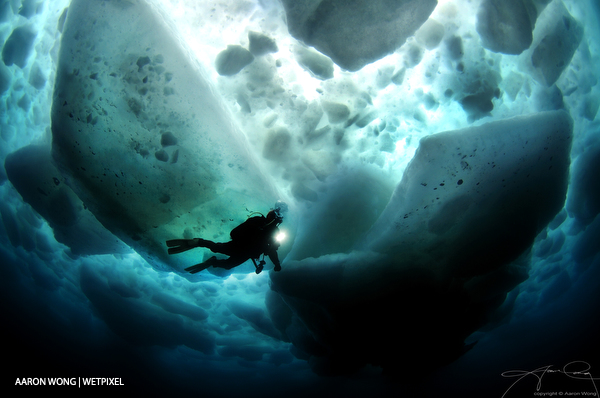
All kinds of stuff. You’re only limited by your imagination. So the moment I started diving, I knew I need to get myself a camera, again money was an issue. Digital photography was in its infancy, let alone underwater housings. So the first camera that I had was a Nikonos V which I still own today, I had a macro lens, I had a wide angle fisheye. And then the second camera I had was a housing that I actually got from Michael Aw. He didn’t know who I was, he just wanted to sell it and then you know I kind of won some of the competitions before, and then he said: “Oh, I’m getting rid of this. Would you like it?” and then I got a f90X, the housing on a film camera, and then slowly I got my first digital, and then the rest, as they say, is history already.
Was it frustrating at first for you in terms of being able to capture what you had in your mind underwater with the equipment, within a different environment?
I mean I guess this is a phase that every photographer who does underwater for the first time will encounter. We all understand the loss of light and the loss of, but unless you are taught basics like that, then you don’t understand it right. And back in the 90s early 2000s, there weren’t a lot of books about underwater photography. And then, like everybody else, you have this grand illusion of how you want to shoot it, then when you shoot it, and it’s just grossly under colored, everything is cyan. And then you start to read about it, and you realize: “Oh, the loss of colors.” But I think it was a little bit easier for me, because I kind of had the background already, the concept of f-stops and shutter speed and ISO it’s already in my blood. So then you start to adjust to the underwater world. And I think that progression was quite easy for me just because I already had a lot of experience in the studio.

Was there a teacher or inspiration in terms of underwater photographers at that stage?
OK, yeah, I know it’s gonna sound very clichéd, but I’ve always admired David Doubilet. And this is because I was exposed to his images in National Geographic. I remember the barracuda shot. I think it was done in 1976 or something like that. And I remember being very impressed by the fact that there are no bubbles in it. And I was not even really big on diving yet. But I kind of understood actually: how do you shoot upwards (and this is before we had rebreathers right), how do you shoot upwards without your bubbles? How long do you have to wait for the bubbles to clear? Well, I mean I remember thinking about all that stuff. So David was definitely one of my inspirations. I looked at his book, and I actually have his book (Water, Light, Time), that’s the Bible. To me, it’s still relevant until today, and his images are not technically, or in terms of composition, or in terms of colors, not the most complex. Some of his stuff is very simple, but it’s just the composition and his ability to tell stories from simple frames that makes it work so well. I remember one of the shots. The toes of probably a tourist with painted nails and there were some, I don’t know what fish that was, but they were just around the toes of somebody, and they were wriggling the toe, and the fish would come to it. It’s a simple thing, but he captured it very nice nicely, and of course you know the barracuda, and then the half water with the ray. I mean everybody does it now but… You know it’s even been done way better than that but…
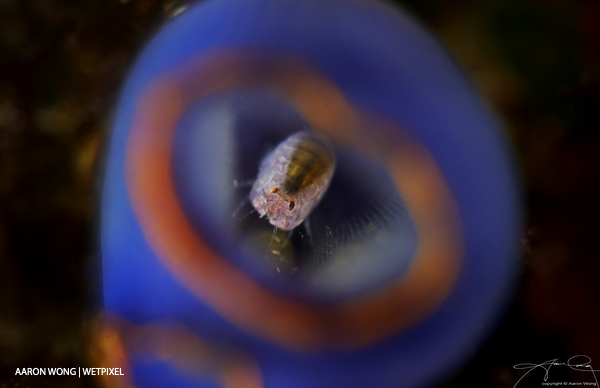
I think it’s easy to forget today with the technology, the equipment that we have, when you look at ‘Water, Light, Time’ maybe the images do stand the test of time in a sense but put them in a competition today, and they wouldn’t stand out in the same way. And it’s easy to lose sight of what it was like back then. I mean it’s 30 exposures from one dive. No idea what you captured until two weeks later…
Exactly. Yeah, exactly. And you know to mess around with strobes back in those days, to calculate your strobes, exposure, all that without digital is just very, very difficult to do.
You started on film on the Nikonos V?
Yes, but spent very little time with the Nikonos, to be honest. But you know Nikonos is a great way because you need to measure the distance for your focus. You’ve got to move your f stop all within the three meters to eight meters you get things in focus, that kind of stuff because it’s not an SLR. I mean have you worked on the Nikonos? It’s got a little knob in it with two small little arrows and as you change the f stop these two small arrows will move closer or further apart. And there are small numbers there, and these are the distance in feet. So that’s telling you where your lens is focusing. So if you have f8, well you know they say; “f8 and be there”, it’s going to be sharp from here to here. And that’s just to get it in focus! So, David, I’m sure he used an SLR, but a lot of the stuff in that book was on film. And the other one that I really admire a lot is Mr. William Tan, he’s from Singapore, and he had a book called Silent Symphony, macro but it’s shot entirely on film, very polished, very well exposed. I would say art photography, like fine art macro stuff on film. And I just fell in love with that whole texture that he managed to do. So yeah these were the two people that I looked up to and stood out for me.
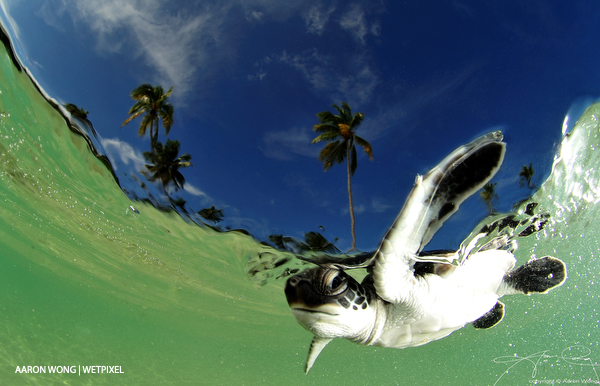
Can you look back and think that this was the turning point, this was when people started to know Aaron Wong within underwater photography circles - is there a moment in time that you look back on?
Yes, definitely. I believe it is the early 2000s. In every era, there’s a look to stuff. I would say in the 70s and 80s, it’s very clean, very colorful, very matter of fact. This is how the underwater world looks like. Think of it as tourism photos, postcards. And there was a time that all the pictures were like that, and then from the 90s to 2000, things become more sophisticated, a bit more polished. And at about that time I was very interested and very keen on taking dark pictures. It’s just my thing. You know I mean look at me: I’m all in black, my water bottle is black, my entire gears are black except for the Seacam. So I just like black stuff, underexposed stuff, high contrast, very good texture that comes up from the light.

And it’s quite common now, but if you think about it in 2000 or 2002 it was not that common to be shooting anything with a black background, or a sunburst that’s so underexposed it looks like the moon. And then I was looking at some of the paintings from Wyland. You know he paints all these very surreal images. A whale with a sunburst and then the dolphins are jumping up. And I’m thinking why can’t we capture something like this because this is so stylized and it’s so creative, it’s art. Why can’t we shoot the underwater world like this?! Because in the end, the camera is still a tool, we paint with light instead of with a brush and oil, but we can’t do things like that. And so I started shooting way underexposed wide-angle stuff. So the sunburst took on another dimension: it’s no longer just blue with a ball of light, it’s really dark at the edges, vignetted like crazy. And then you have a very well lit front subject, a wide angle close up, with a nice sunburst in the back. That kind of stuff back in the early 2000s. And I did one particular shot, of a grouper. It was the weirdest thing ever. We were coming out of the water, a very shallow dive, and we were doing our safety stop, then there was some tourist boats there feeding, they would throw bread into the water, and the sergeant majors are eating it, and then all of the fusiliers. And then there were a few, and there was a grouper. Strangely enough, a juvenile grouper darting around with all this trying to get scraps. And I was thinking wouldn’t it be cool right. And so I grab one of the floating pieces of bread and kind of dangled in front of my camera for a while. And I was hoping, OK I’m just going to prefocus, I put my hand in front of maybe two or three inches from the port, prefocus and I’m just going to hang this here. And if anything swims remotely close it’s just gonna be a knee jerk reflex, I’m just going to shoot it anyway. But I knew I wanted to get a sunburst in the back. So I just aligned my camera with the sunburst. I’m just like two meters underwater and just waiting for something to cross my frame. I mean I must have done hundreds of shots of weird stuff passing, and then this grouper came, and in that one-second he turned, and I took a picture. I didn’t know I got a shot because I’m not looking at the reviews. And then after that, I left, and I ended up capturing a fantastic, pin-sharp picture of a grouper turning with a sunburst in the back.
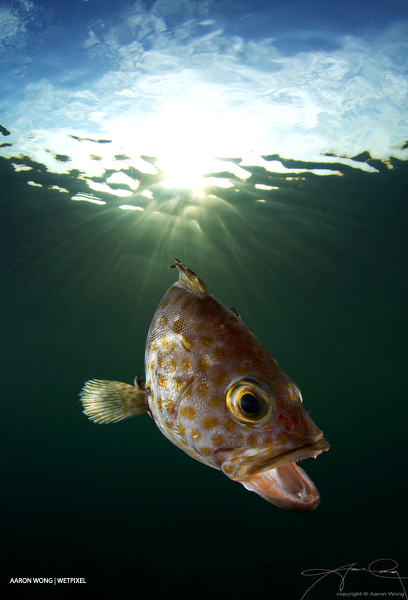
It looks like cut and paste, but I swear to god it wasn’t. And I tried to send it into a lot of competitions. And it didn’t even get to the finals of anything or even the semifinals of anything in Asia. And I was very disappointed. I’m thinking maybe what I like is simply not good enough. OK, maybe this sucks. I mean who’s to say you know. And then along came the BBC Wildlife Photographer of the Year and I thought OK you know aim for the stars and maybe you hit the moon. So I submitted that one and I realized it was so difficult because the BBC is a very serious competition. You send in your JPGs, and if it gets selected they’ll ask for your RAW, and this was in the early 2000s, so they were really strict. And if your RAW was even remotely not close to your JPG, you’re out of the competition. And so I submitted it, and I won.
You won the underwater category?
It was an animal portrait, and I was in the book 2008 BBC. Yes, I was placed within that category. Which is a big thing back in the day, and for a Singaporean. And then that is the moment I feel. It’s not that my style isn’t nice, but I felt that at the time a lot of magazines and other underwater competitions are just not ready for it. That’s how I felt. But to me, that moment was like an assurance that this thing works. Just that not everybody can understand, it but slowly they will. And so from then on I just stuck to it. And then before I knew, it kind of developed into a style and then the magazines kind of liked it and then you see, I’m not saying people are copying, but I would dare to go as far as saying that I kind of pioneered this look. Everybody does it now, and it’s flattering…great. I don’t think that they copied it, but I inspired this whole look.
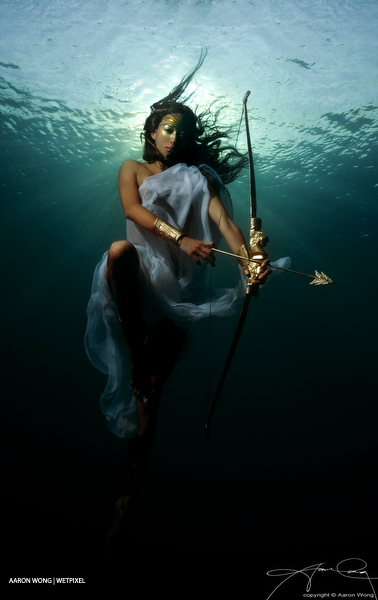
Which is the ultimate compliment really…
Yeah I think it’s really cool and then people are saying: “Oh, I love this whole idea,” but it’s just like blackwater now. Somebody did it, I don’t know who started it, and now everybody’s doing blackwater for example. So that’s the trend, you know. I would say I started this whole dark wide angle shots and I started really focusing a lot on wide angle close-ups. So the subject in front of the camera is very well lit, done perfectly, and I approach the lighting like I would in a studio. Yes. So whatever’s in front of my camera. It’s like a mini studio. The sun is just a backdrop. Yeah, that’s it.
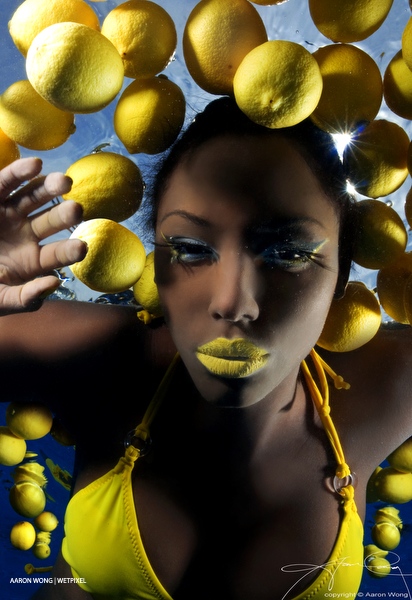
I was looking at your images, and we talked about how photographers, we paint with light…Well actually I like the concept that you paint which shadow, you’re a master maybe of shadow. For me, that’s what stands out as the Aaron Wong Style…
You are actually are completely right. So I think we are speaking the same language. When I started giving a lot of workshops back in the day, I was always telling people their shadows are very important. It tells you where things are in space. If you have flat lighting, you know like a moon, like a full moon, it’s just flat. Whereas if you have a crescent moon, you look at it even with your naked eye and you can see the little craters and textures on the moon. Just like if you were to shine at an orange with a torchlight from the side. You can see all the little textures, but if you put it directly beside your eye and shine straight at it, it is going to be flat, so textures are what make things pop. That’s why when you do fine art sketching, in school when you learn basic art and craft, the teacher will put an apple beside an open window and draw it, and you are often given a subject that is round because they want you to understand a concept of a key light, a highlight, a mid-tone, and a shadow that makes something look three dimensional. So without shadows, you can’t see. You don’t have any contrast to bring stuff up. So shadows are the ones that actually make things work, and as a commercial photographer, we also train to sell stuff. I mean that’s what a commercial photographer does right? We sell stuff. So our concept is if it’s nice, we show it. If it’s not nice, we hide it. So same thing, if you look at a reef, it can be a bit messy and a busy shot. A lot of things are happening. So if you throw it into the shadow, and it’s just black, and you focus on one thing that’s in front of you, say a frogfish. Light that stuff to perfection. Everything else is black. The only thing that gives a bit of light in the back is a sunburst. And then all of a sudden it becomes a very stylized and simplified version. But there’s a lot of thought into it. You know it looks simple, but as I always say: simplicity is an awfully complicated process. It takes a lot of time to think like that.

In this series, I like to talk to the photographers about their process, so maybe people listening or reading can pick up a few little things. What’s your process for taking an underwater photograph both before, during, and after, some things that you could share with us?
For any underwater photographer, you need to have a very good grasp of what constitutes a nice image. You need to know what a nice image means to begin with. Of course, you can’t plan a lot of stuff. In fact, you can’t plan most of the stuff when you dive. You don’t know what you’re going to see. You don’t know what nature is going to throw at you, but If you have a good grasp of how a good image classifies, and when the opportunity presents itself you have this archive subconsciously of images that: “Ahh, this will be cool.” So when you approach a subject or when you approach a picture, I think the first thing is you must have a mental idea of what you are about to shoot. This will determine which angle you are going to approach this subject. So that’s number one I feel.

With a bit of experience you will know that certain subjects will work, certain subjects won’t. Let’s say if I were to be swimming along and I see this sea fan along the wall, sticking out at a perfect angle, it’s not near to anything else, and it just happened. The sun was behind me say for example, and the sea fan is in front of me, I know that I should go to the other side of the sea fan to shoot against the sun to get the sunburst. So all this is a process, and you only know that because you know what you want to get. Because most people just swim up to the sea fan, with the sun behind them because this just happened to be the direction they are diving, just go click click and then go along. But you should go to the other side of the sea fan, face the other direction and shoot it because this is a thought process. Know what you want to shoot subconsciously, have a rough idea of how the framing should be. This will determine where you’re going to end up, where you’re going to frame your camera, and of course, as you go along know the kind of subjects that will work. So in this example of a sea fan, you know it’s perfect because you have somewhere to hide into to shoot outwards and if it’s sticking out far enough. And then you know “maybe it would be cool to have a diver in the background,” and if you happen to have the rest of your group coming along and you’re in front you think: “Oh, let’s do that. Because I’ve seen pictures of these guys” and maybe you wave to your friend. Let’s move in a little bit, get a shot. Things like that. Of course, the next thing that comes will be you knowing your exposure and what should I do with the lights and all that stuff. For me it’s pretty straightforward because I always have, let’s say for wide angle, I always have my strobes as far apart as possible. This is a tip I’ll give everybody: if the strobes are too close to your lens you end up having an image that looks like car headlights. It looks like a pair of headlights shining at a deer. Everything is flat. It looks like a mug shot. If the lights are further away from you, like how we would in a studio - we hardly ever put the light beside the camera, we always put it by the side. So there is no difference underwater, bring the strobes as far as you can, as far as your sync cords will allow, to the sides and then turning back towards you. And then go close.
Turn the strobes back towards the subject?
Depending on how far the subject is, if it comes closer to your camera, say maybe a meter or two. You want to cut your strobes in a little bit or use the edge of your light. But of course, there is a danger if you cut it into much you get scatter and all that stuff. So if you want to use the edge of your beam that’s great as well. But then of course in order to do that you need to have some kick-ass, big strobes, which is why I carry these Sea & Sea 250s, even though they are discontinued. David and I swear by these strobes because you get the power that you need, just even the beam of it is enough to get an f8.

And strobes equal power?
It depends on how you want to shoot it but ninety-nine percent of the time I will have one strobe that is full power, the other maybe half or even less depending, and that’s just my training as a photographer. It’s like Rembrandt, painting with one source of light. It could be a candle, an open window, But what I believe in is the original single source of light is the sun. So I kind of like the idea that you need to have a key light. When your audience looks at your pictures, there needs to be a key light. There needs to be the mid-tones and then the shadows falling off. And of course, if it falls off to black, then it just merges into the background, that’s where your second strobe fills in a little bit, to make it not perfectly black. Not completely dark, there is a little bit of texture in it, just enough to see. So this is one of the things that you’ve got to consider: separation. How you want to separate your subject from the background. And this has to come with experience, and if you look at some of the great images, you’ll realize that it pops so much because it is well separated from the background. If it’s a busy background or a lot of reef and then you have a fish that looks almost the same color as the reef, then we know it’s a fish, but that’s it. Right. It doesn’t stand out. So if you can do it well, if you know how to cut your light nicely, you know how to use shadows, you can separate a pygmy seahorse that looks exactly like the sea fan that it’s living on. But yet you can see it super clearly, super defined, because it is well separated. It’s just an art.

Good advice would be getting a torchlight on land and get a small piece of tissue and roll it up into a ball on the table, get a little torchlight, move it around and you know put a tissue (or a pencil) on the table, move your legs around and just imagine if this was a nudibranch. Put the light on the table, cut it across. You will realize you can even separate something as small as a grain of rice. Think about it, if you drop a pin on the floor and you’re trying to find it if you turn on a torchlight standing up and you shine on the floor you will have a hard time finding it. But if you put the torchlight on the floor, you will realize that you cannot only find it, but you will realize how dirty your floor really is! Because then you see strands of hair, dust, specks of stuff that you didn’t even know was there. And these will all be illuminated because the light is skimming across the surface. So this is what I mean by lighting, and this is what I mean by cutting light, separation. If you’re good at it, you can separate the smallest thing on the smallest piece of coral. It can be done. And I’ve got a lot of pictures of small little I don’t even know what they are, they look exactly as the coral that they’re standing on, but with the right lighting, you can separate. If you look at my book, you see a lot of pictures of gobies, common gobies, that are just so well lit that they look so special. So that’s what I always say: the best picture of a common species can beat a normal picture of a rarer species anytime. You know, if you can shoot your neighbor’s cat in a way that nobody has shot a cat, you will win a competition against somebody who will shoot another lion in Africa.
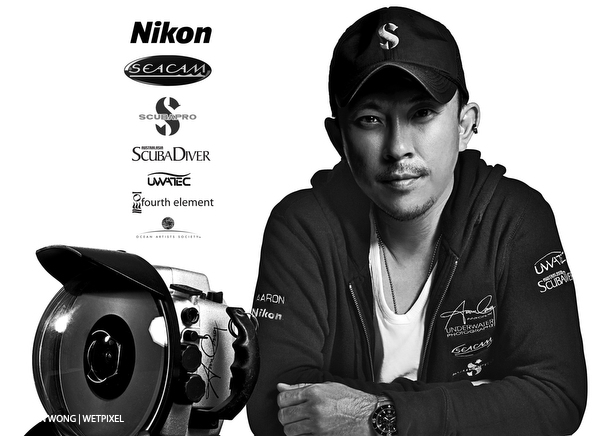
You can see more of Aaron’s work on his website. He is also on Facebook and Instagram.
To see Henley Spiers work, please see his website.